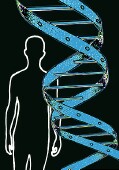
FRIDAY, April 12 (HealthDay News) — As scientists mark the 10th anniversary Sunday of the completion of the Human Genome Project, they will note how that watershed effort has led to the discovery of the genetic underpinnings of almost 5,000 diseases.
And it has made it possible to develop personalized treatments that have prolonged the lives of many.
But the scientists will also acknowledge that, while the project has unlocked many mysteries that once shrouded diseases, there’s still much to be learned before new drugs can be developed to target illness-causing mutations in human DNA.
“What we’ve learned over the past 10 years is that we’re still far from really understanding the complexity of the human genome,” said Eric Schadt, chairman of genetics and genomic sciences at Mount Sinai Icahn School of Medicine in New York City. “Human disease is way more complicated than the old view that single hits to single genes cause diseases.
“In most forms of diseases, it’s whole constellations of genes operating in networks,” Schadt explained. “That becomes a much harder problem. How do you target networks with a single drug?
“We keep learning how much we really don’t know and how much further we need to go,” he added. “That’s the big story.”
A decade ago, the Human Genome Project was hailed as a major milestone because researchers identified all of the nearly 25,000 genes in human DNA and sequenced the 3 billion chemical base pairs comprising that DNA.
The feat took 13 years and cost close to $3 billion, but the genetic information gleaned from the project gave scientists the tools needed to pinpoint how changes in specific genes could kick-start some diseases.
One of the most tangible benefits of the project has been the development of ever more sophisticated sequencing technology and a dramatic lowering of the cost of using that technology.
Today, the cost of sequencing one human genome is closer to $5,000 and can be done in a day or two, said Dr. Eric Green, director of the National Human Genome Research Institute in Bethesda, Md.
What that means is that the pace of research, and its attendant discoveries, has been accelerated.
When the project first began, scientists knew the genetic basis of about 53 diseases. Today, that number is close to 5,000, Green noted. That means doctors can now test patients to see if they carry gene mutations that raise their risk for certain diseases, and counsel them accordingly on ways they might prevent or delay illness. There are currently almost 2,000 genetic tests for specific diseases or conditions, according to the U.S. National Institutes of Health.
There have also been breakthroughs with some rare diseases.
In 2011, 6-year-old Nicholas Volker became the first child to be saved by the new technology. He had undergone a hundred surgeries, including the removal of his colon, as doctors tried to identify his mysterious bowel disease. Genomic sequencing uncovered a genetic mutation that could be treated with a bone marrow transplant consisting of cells from umbilical cord blood.
“Knowing more of the basic genetics that makes up an individual has allowed us to diagnose far more genetic diseases,” said Dr. Barbara Pober, a medical geneticist at the Frank H. Netter, M.D. School of Medicine at Quinnipiac University in North Haven, Conn.
Once a diagnosis has been made, doctors can now use gene sequencing to determine treatment for some diseases. For instance, breast cancer patients can be tested to see how they will respond to the drug Herceptin. HIV patients can be tested to determine their response to the drug abacavir. And those on the widely used blood thinner warfarin can be tested to determine the most effective dose, according to the NIH.
The field of pharmacogenetics, still in its infancy, enables doctors to use a patient’s genetic information to figure out which cancer drugs the patient will best respond to before treatment even starts.
The U.S. Food and Drug Administration now includes genetic information on labeling for more than 100 drugs, up from just four 10 years ago, Green said.
The goal of developing new drugs to target diseases with genetic roots, however, will take much longer to realize.
Although the NIH states that there are roughly 350 biotechnological products currently being tested in clinical trials, new drugs take a decade or more to develop. Not only that, the knowledge gained from the Human Genome Project has actually made the field of genetic medicine even more complex. Scientists are finding that many diseases are triggered by interaction involving multiple gene variants, making it difficult to design a treatment that targets all the culprits in a particular illness.
And the complexities don’t end there.
Not long ago, scientists discovered that so-called “junk” DNA, which makes up 98 percent of the genome, is not junk at all but serves critical regulatory functions.
What’s more, about 10 percent of the human genome still hasn’t been sequenced and can’t be sequenced by existing technology, Green added. “There are parts of the genome we didn’t know existed back when the genome was completed,” he said.
More information
For more on developments over the past 10 years, visit the Human Genome Project website.

